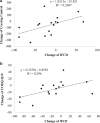Effect of combined naltrexone and bupropion therapy on the brain's functional connectivity
- PMID: 29535451
- PMCID: PMC6107443
- DOI: 10.1038/s41366-018-0040-2
Effect of combined naltrexone and bupropion therapy on the brain's functional connectivity
Abstract
Background: The control of food intake in environments with easy access to highly rewarding foods is challenging to most modern societies. The combination of sustained release (SR) naltrexone and SR bupropion (NB32) has been used in weight-loss and obesity management. However, the effects of NB32 on the brain circuits implicated in the regulation of food intake are unknown. Here we used functional connectivity density (FCD) mapping to evaluate the effects of NB32 on resting brain FC.
Methods: Thirty-six healthy women underwent magnetic resonance imaging (MRI) before and after 4-week treatment with NB32 (n = 16) or with placebo (n = 20). In each imaging visit, a 5-min resting-state functional MRI scan was conducted after 15 h of fasting. The FC of brain regions showing significant group effects on FCD were subsequently assessed using seed-voxel correlation analyses. We characterized the associations between FCD measures and craving control scores in the Control of Eating Questionnaire.
Results: After NB32 treatment, the group showed lower local and global FCD than the placebo group in the right superior parietal cortex and lower local FCD in the left middle frontal gyrus. Seed-voxel correlation analysis for the right superior parietal cortex seed demonstrated higher positive FC with the dorsal anterior cingulate gyrus (ACC), bilateral insula, and left superior parietal gyrus and stronger negative FC with right inferior frontal gyrus and right superior parietal cortices for the NB32 than the placebo group. Further, the NB32 group showed a significant correlation between local FCD change after treatment in left middle frontal gyrus and craving control scores (r = 0.519, p = 0.039).
Conclusions: NB32 treatment decreased local and global FCD in superior parietal cortex and increased its connectivity with ACC (involved with saliency attribution), insula (interoception), and decreased local FCD in the medial prefrontal cortex (craving), which might underlie NB32 improved control over eating behaviors. ClinicalTrails.gov: NCT00711.
Trial registration: ClinicalTrials.gov NCT00000711.
Conflict of interest statement
G-JW reports having received lecture fees and research funding from Orexigen Therapeutics Inc.; JZ, DT, RW, ESK, CEW, ECC, and NDV report no biomedical financial interests or conflict of interest.
Figures



References
Publication types
MeSH terms
Substances
Associated data
Grants and funding
LinkOut - more resources
Full Text Sources
Other Literature Sources
Medical
Molecular Biology Databases
Research Materials

